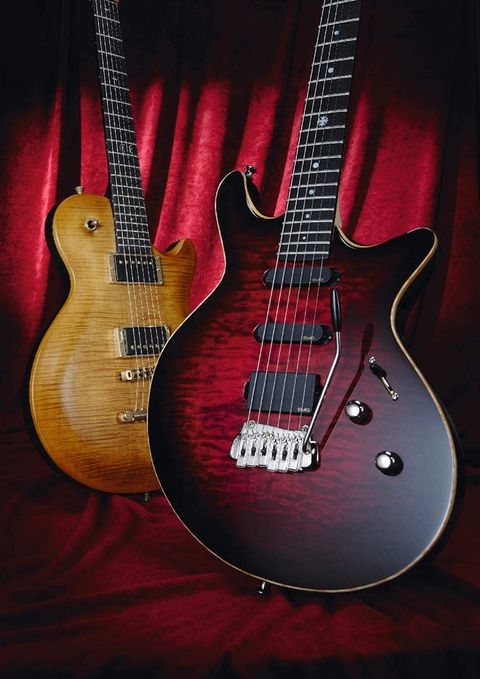Many readers would be forgiven for thinking that Lag is a new name on the guitar scene and that the range slugs it out at the bottom end of the market with other brands spewing out of Asia.
But Michel Lâg started his company more than two-and-a-half decades ago, building low-production, premium models that were played by the likes of The Scorpions and Motörhead.
The understated but regal looking Imperator (it's Latin for Emperor) sits on the Kalamazoo/Nashville side of the fence with its carved top, single-cutaway, twin-humbucker styling.
Overview
Monsieur Lâg explains the raison d'etre behind the Imperator, his latest creation: "It took more than a year of intensive work to achieve what I wanted: a classic and elegant look without copying, and a big modern sound without unacceptable weight." Even a quick glance at this simple but elegant guitar tells you he's hit the target. Pick it up and that suspicion is confirmed.
"Each part of this instrument is carefully selected and combined," Lâg continues. "African mahogany - not heavy but with a really fat sound - a beautiful soft maple with perfect tonal balance and a warmly resounding three-ply mahogany neck. Then two Special DiMarzio pickups custom made just for Lag with their genuine black satin metal covers."
It's the detail that makes the Mastershop Lags so pleasing to behold. Take the Imperator's slightly 'art nouveau' peghead facing: it's ebony with a raised centre section that adds nothing in practicality, but everything in what Michel dubs "rock chic".
And how about those delightful crown inlays on the ebony fingerboard? All this does nothing for the guitar's sound or feel, but everything for its class and desirability.
The ebony 'board is also ebony bound, so the fret tangs are completely hidden - another unnecessary but thoughtful and welcome touch. And why stick boring old nickel or bright gold hardware on such a guitar, when what Michel terms "warm gold" - with the patina of age - looks so much better and complements the satin finish flamed maple top so well.
Body base and neck are both African mahogany - the neck a three-piece and the body a two-piece book-matched construction.
The maple top looks as though it could have come from an old violin maker's stocks, so tight are the tiger stripes and so deftly has it been stained and satin finished.
This is perfectly flat - as are the opaque brown back and neck - not 'straight off the spray-gun' as we see with so many other mock vintage guitars.
No corners have been cut in the hardware department either: the tulip-buttoned tuners look like Gotoh, and the High Precision bridge and stud tailpiece certainly are - the retro-style bridge locks on to its legs for added security and tone transference.
Everything about the Imperator's build and style is top notch, and that extends to the pickups, which are special design DiMarzios made only for Lag. These are mated to individual volume controls with Yamaha-style push-push coil-splits; a master tone is the third knob, which is sited nearest the rim-mounted jack socket.
Strangely though, Lâg has sought to orientate his three-way pickup selector and controls in defiance of convention. For a start, the switch works left to right, not up and down as on a Gibson; secondly, the bridge pickup's volume is towards the neck, and the neck pickup's towards the bridge.
This not only flies in the face of what we expect; it also contradicts the switch - bridge is right, neck is left. And as Michel himself points out, "people don't just play one guitar all their life", so why make it unnecessarily awkward when they change from their Gibson to their Lag?
Thankfully there are no surprises when it comes to the Imperator's playability. Its medium 'C' shape neck (that typically for Lag uses two titanium reinforcing rods either side of the truss rod) would suit almost any player, while the 22 medium frets are set and finished with the same attention to detail that characterises the rest of the guitar.
To say it plays unremarkably sounds like a criticism; it's not, it simply gets on with the business and lets you think about the notes - and isn't that how it should be?
Playability is aided by the 'thinner than Les Paul' design, and an elegant curved body heel that eradicates the bulk usually associated with this style of guitar and provides for an almost bolt-on-like appearance.
Sounds
Cutting down on body mass removes some of the full-on tone that one gets from a Les Paul. But many players prefer the more dynamic nature of a 335 or SG and that's the Imperator's ballpark.
The humbucking tones, while tight and focused like a Les Paul, are lighter and seem to breathe more. The bridge pickup's dark bite is complemented by a softer, jazzier tone from the neck DiMarzio.
Engage the coil-splits and the sounds thin out somewhat. But the set neck and mahogany/maple construction keep the tones dark, retaining their moody character.
Play riffs and crunch rhythm with the coil-splits on, and kick the humbuckers into life for fluid leads; the permutations are vast but every tone fits the guitar's look and vibe perfectly. There's nothing Fender about it; it's Gibson 'full-fat' and Gibson 'lite'.

